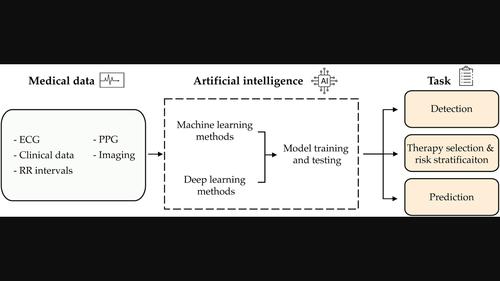当前位置:
X-MOL 学术
›
WIREs Data Mining Knowl. Discov.
›
论文详情
Our official English website, www.x-mol.net, welcomes your
feedback! (Note: you will need to create a separate account there.)
Artificial intelligence for atrial fibrillation detection, prediction, and treatment: A systematic review of the last decade (2013–2023)
WIREs Data Mining and Knowledge Discovery ( IF 6.4 ) Pub Date : 2024-02-04 , DOI: 10.1002/widm.1530 Massimo Salvi 1 , Madhav R. Acharya 2 , Silvia Seoni 1 , Oliver Faust 3 , Ru‐San Tan 4, 5 , Prabal Datta Barua 6, 7 , Salvador García 8 , Filippo Molinari 1 , U. Rajendra Acharya 9, 10
WIREs Data Mining and Knowledge Discovery ( IF 6.4 ) Pub Date : 2024-02-04 , DOI: 10.1002/widm.1530 Massimo Salvi 1 , Madhav R. Acharya 2 , Silvia Seoni 1 , Oliver Faust 3 , Ru‐San Tan 4, 5 , Prabal Datta Barua 6, 7 , Salvador García 8 , Filippo Molinari 1 , U. Rajendra Acharya 9, 10
Affiliation

|
Atrial fibrillation (AF) affects more than 30 million individuals worldwide, making it the most prevalent cardiac arrhythmia on a global scale. This systematic review summarizes recent advancements in applying artificial intelligence (AI) techniques for AF detection, prediction, and guiding treatment selection and risk stratification. In adherence with the PRISMA guidelines (Preferred Reporting Items for Systematic Reviews and Meta-Analyses), a total of 171 pertinent studies conducted between 2013 and 2023 were examined. Studies applying machine learning (ML) and deep learning (DL) to electrocardiogram (ECG), photoplethysmography (PPG), wearable data, and other sources were evaluated. For AF detection, most works employed DL (48 studies) and ML (28 studies) on ECG data. DL methods directly analyzed ECG waveforms and outperformed approaches relying on hand-crafted features. For prediction and risk stratification, 22 studies used ML while 7 leveraged DL on ECG. An emerging trend showed the growing potential of PPG for AF screening. Overall, AI demonstrated promising capabilities across various AF-related tasks. However, real-world implementation faces challenges including a lack of interpretability, the need for multimodal data integration, prospective performance validation, and regulatory compliance. Future research directions involve quantifying model uncertainty, enhancing transparency, and conducting population-based clinical trials to facilitate translation into practice.
中文翻译:

用于心房颤动检测、预测和治疗的人工智能:过去十年(2013-2023)的系统回顾
心房颤动 (AF) 影响着全球超过 3000 万人,使其成为全球范围内最常见的心律失常。本系统综述总结了应用人工智能 (AI) 技术进行房颤检测、预测以及指导治疗选择和风险分层的最新进展。根据 PRISMA 指南(系统评价和荟萃分析的首选报告项目),共审查了 2013 年至 2023 年间进行的 171 项相关研究。对将机器学习 (ML) 和深度学习 (DL) 应用于心电图 (ECG)、光电体积描记法 (PPG)、可穿戴数据和其他来源的研究进行了评估。对于 AF 检测,大多数工作对 ECG 数据采用 DL(48 项研究)和 ML(28 项研究)。深度学习方法直接分析心电图波形,其性能优于依赖手工特征的方法。对于预测和风险分层,22 项研究使用了 ML,而 7 项研究则在心电图上利用了 DL。一个新兴趋势表明 PPG 在 AF 筛查方面的潜力不断增长。总体而言,人工智能在各种与自动对焦相关的任务中展示了有前景的能力。然而,现实世界的实施面临着挑战,包括缺乏可解释性、需要多模式数据集成、预期性能验证和监管合规性。未来的研究方向包括量化模型的不确定性、提高透明度以及进行基于人群的临床试验以促进转化为实践。
更新日期:2024-02-06
中文翻译:

用于心房颤动检测、预测和治疗的人工智能:过去十年(2013-2023)的系统回顾
心房颤动 (AF) 影响着全球超过 3000 万人,使其成为全球范围内最常见的心律失常。本系统综述总结了应用人工智能 (AI) 技术进行房颤检测、预测以及指导治疗选择和风险分层的最新进展。根据 PRISMA 指南(系统评价和荟萃分析的首选报告项目),共审查了 2013 年至 2023 年间进行的 171 项相关研究。对将机器学习 (ML) 和深度学习 (DL) 应用于心电图 (ECG)、光电体积描记法 (PPG)、可穿戴数据和其他来源的研究进行了评估。对于 AF 检测,大多数工作对 ECG 数据采用 DL(48 项研究)和 ML(28 项研究)。深度学习方法直接分析心电图波形,其性能优于依赖手工特征的方法。对于预测和风险分层,22 项研究使用了 ML,而 7 项研究则在心电图上利用了 DL。一个新兴趋势表明 PPG 在 AF 筛查方面的潜力不断增长。总体而言,人工智能在各种与自动对焦相关的任务中展示了有前景的能力。然而,现实世界的实施面临着挑战,包括缺乏可解释性、需要多模式数据集成、预期性能验证和监管合规性。未来的研究方向包括量化模型的不确定性、提高透明度以及进行基于人群的临床试验以促进转化为实践。

































 京公网安备 11010802027423号
京公网安备 11010802027423号